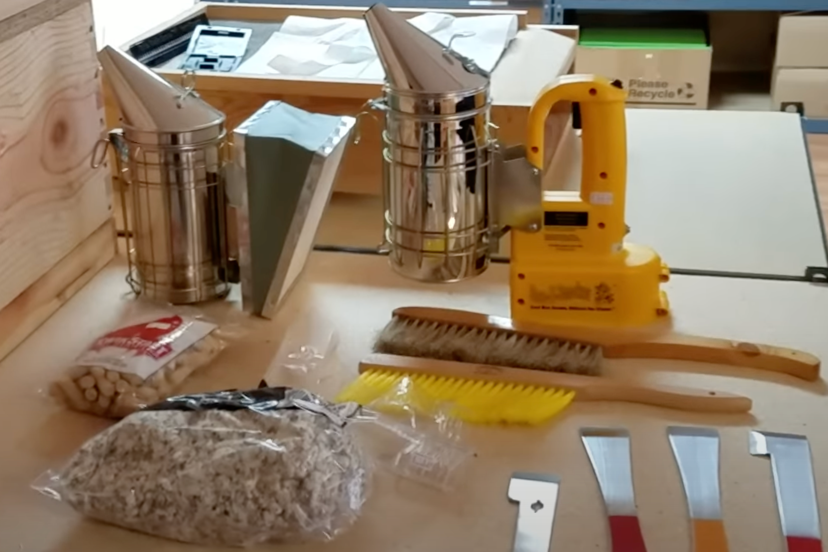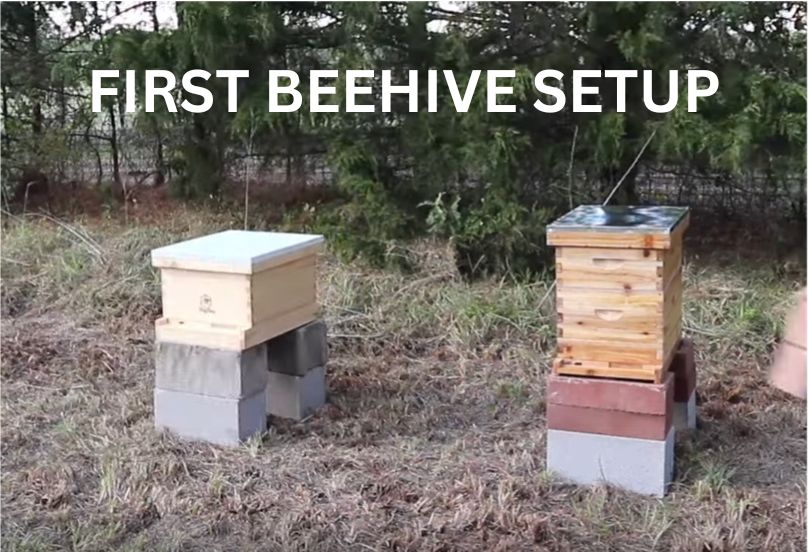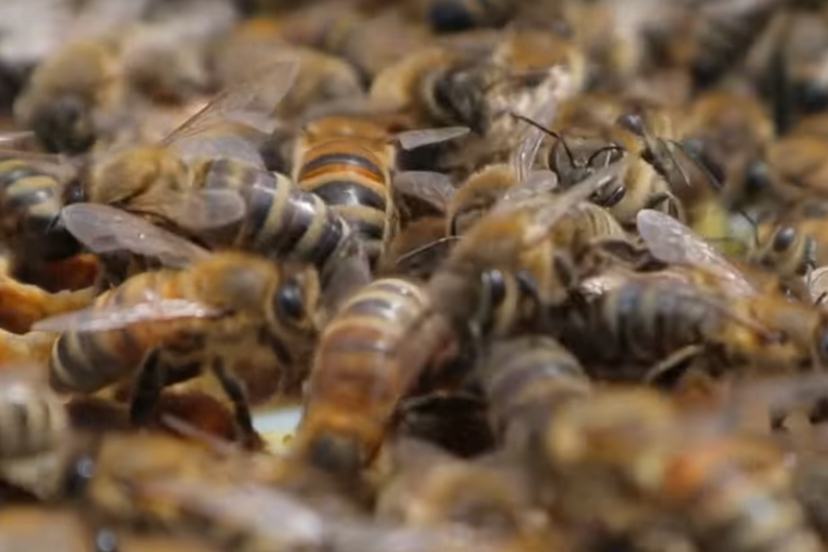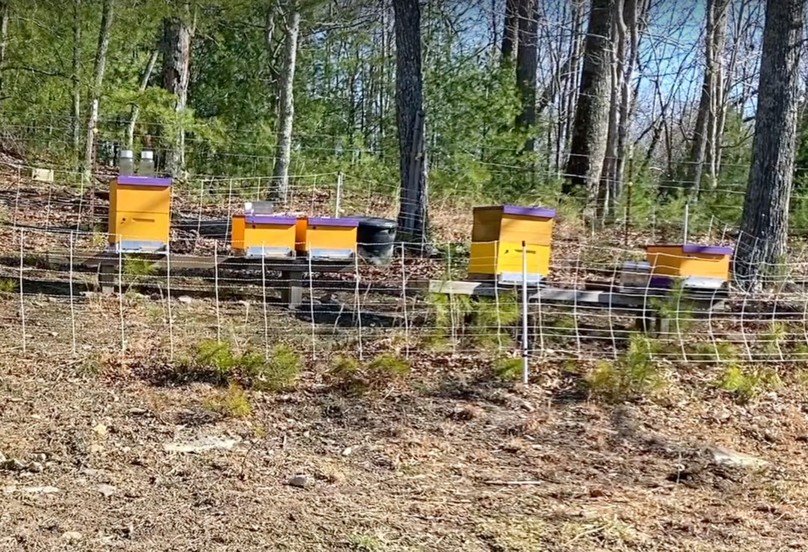You’re about to dive into the fascinating world of queen bees – the heart, soul, and ovaries of every healthy hive. Did you know that a single queen can lay up to 2,000 eggs per day?
In this guide, we’ll explore why the queen bee is the MVP of your hive and what you, as a new beekeeper, need to know to keep Her Majesty (and her loyal subjects) happy and thriving.

So, straighten your crown, grab your royal scepter (or hive tool), and let’s get buzzy with some queen bee wisdom!
- 1. The Queen's Role: More Than Just Laying Eggs
- 2. Identifying Your Queen: A Royal Game of Hide and Seek
- 3. The Queen's Lifecycle: From Egg to Royalty
- 4. Signs of a Healthy Queen: Keeping Tabs on Her Majesty
- 5. Queen Problems: When Things Go Royal-ly Wrong
- 6. Replacing Queens: Out With The Old, In With The New
- 7. Raising Queens: DIY Royalty
- 8. Swarm Prevention: Keeping Your Queen Home
- 9. Seasonal Queen Care: Year-Round Royal Treatment
- 10. Advanced Queen Management: Looking Ahead
- The Final Buzz:
1. The Queen’s Role: More Than Just Laying Eggs
When I first started beekeeping, I thought the queen was just an egg-laying machine. Boy, was I wrong! She’s the heart and soul of the hive, influencing everything from behavior to productivity.
Understanding The Queen’s Influence On Hive Behavior
The queen’s presence keeps the whole colony in harmony. I once saw a queenless hive – total chaos! But it’s not just about keeping peace. She shapes the entire colony’s personality. I’ve had gentle queens producing the sweetest bees, and feisty ones making hives so defensive I’d suit up just to walk nearby!
Pheromone Production And Its Effects
Her superpower? Pheromones. She’s constantly pumping out chemical signals affecting worker behavior, colony development, and even foraging patterns. When pheromone levels are high, workers forage like crazy!
The Queen’s Impact On Colony Productivity
A strong queen can lay up to 2,000 eggs a day during peak season – more than her own body weight! This constant influx of new bees keeps the workforce strong and productive. A good queen lays in a tight, uniform pattern – it’s like art!

But a failing queen can bring the whole hive down. Poor laying can make the population dwindle and productivity plummet. That’s why monitoring your queen’s performance is crucial.
What still amazes me is how workers treat the queen. She’s got her own little entourage! But here’s the kicker – she’s totally dependent on her workers. Can’t feed herself, can’t clean herself, can’t even regulate her own temperature.
Understanding the queen’s role is key to successful beekeeping. Treat her right, and your hive will thrive!
2. Identifying Your Queen: A Royal Game of Hide and Seek
Finding the queen can be tricky, but I’ve got some tips for you!
Physical Characteristics Of Queen Bees
First, physical characteristics. The queen’s usually longer than workers, with a tapered abdomen – like a stretch limo in a parking lot of compact cars.

She’s got a larger thorax, longer legs, and shorter wings compared to her body. Color varies; I’ve had queens from tuxedo-dark to practically glowing!
Behavioral Clues To Spot The Queen
Behaviorally, the queen moves slowly and deliberately. Workers often form a circle around her, facing inward – like paparazzi around a movie star! You might notice workers making way for her. Pro tip: look for eggs. The queen’s usually nearby.
Tips For Marking Queens For Easy Identification
Marking queens is a game-changer. The standard system uses different colors for different years: white, yellow, red, green, blue, then repeat. Easy to remember: “Will You Rear Good Bees?”

When marking, steady hands are key. I use a marking tube to keep her still. A dab of paint on her thorax, and voila! Just be gentle. Some beekeepers use numbered tags instead of just color dots.
Remember, practice makes perfect. Don’t get discouraged if you can’t spot her right away. If you see eggs but can’t find the queen, don’t panic. She’s in there somewhere, just playing hard to get.
Identifying your queen is crucial for monitoring hive health. Plus, there’s something magical about spotting her majesty among thousands of workers. It never gets old!
3. The Queen’s Lifecycle: From Egg to Royalty
The queen bee’s lifecycle is a real rags-to-riches tale. It all starts with a regular egg, chosen by workers for royal treatment. These lucky larvae get fed royal jelly – bee superfood.
This special diet transforms a regular larva into a queen in just 16 days, compared to 21 for a worker. Talk about a growth spurt!

Virgin Queen Behavior And Mating Flights
When the virgin queen emerges, she’s got one thing on her mind: taking out the competition. After a few days, it’s time for mating flights.
The queen flies to drone congregation areas – like a singles bar for bees! She’ll mate with multiple drones mid-air. These flights are crucial; a well-mated queen can store sperm for years.
Lifespan And Productivity Changes Over Time
A good queen can live 3-5 years, but most beekeepers replace them more often. I usually requeen every 2 years to keep the colony strong. In her prime, a queen can lay up to 2,000 eggs a day! But as she ages, egg-laying slows and becomes less consistent, here is a picture of a spotty brood pattern.

As the queen ages, her pheromone production decreases, which can lead to decreased productivity or workers trying to raise a new queen.
Watching a queen go from a tiny larva to a productive monarch never ceases to amaze me. It’s one of the many wonders that keeps me buzzing about beekeeping, even after all these years!
4. Signs of a Healthy Queen: Keeping Tabs on Her Majesty
Keeping tabs on the queen is crucial for a thriving hive. Let’s buzz through this royal health check!
Assessing Brood Patterns
First, assess brood patterns. A healthy queen lays eggs in a nice, tight pattern. I use the “dollar bill test.” If you can’t see more than 10-20 empty cells under a dollar bill on capped brood, you’ve got a good laying pattern. Check for eggs and young larvae too.
Monitoring Egg Laying Rates
For egg-laying rates, I use the “frame count.” In spring and summer, you should see about 6-8 frames of brood in various stages. Remember, rates change with seasons and the queen’s age. A young queen lays more eggs than an older one.
Observing Worker Bee Behavior Around The Queen
Observe worker behavior around the queen. In a good hive, workers form a ‘queen’s court,’ treating her like royalty. Workers ignoring or acting aggressive towards the queen? Red flag! Watch for supersedure cells too – if present, workers think it’s time for a new queen.
One thing I’ve learned: bees often know what’s best. If they’re trying to replace the queen, there’s usually a good reason.
Trust your gut. If something doesn’t look right, it probably isn’t. Every hive is unique, so get to know yours and check regularly.
A healthy queen means a healthy, productive hive. There’s nothing quite like the satisfaction of seeing a happy, healthy queen hard at work!
5. Queen Problems: When Things Go Royal-ly Wrong
Even in the bee world, things can go royal-ly wrong. Let’s talk through these queenly troubles!
Identifying A Failing Queen
Identifying a failing queen is like being a bee detective. Watch for spotty brood patterns – I once saw a hive where the brood looked like a bad game of connect-the-dots. Red flag!
You might notice dropped egg production or eggs in weird places. Hive temperament changes are another clue. I had a gentle hive turn nasty in a week due to a failing queen.
Dealing With Queenless Colonies
Queenless colonies are like ships without captains – chaos! Bees get antsy, running around searching. Without queen pheromones, workers might start making emergency queen cells. If you suspect queenlessness, introduce a new queen or give them eggs from another hive.
The Menace Of Laying Workers
The real menace? Laying workers. It’s the bee version of a coup d’état. In a queenless colony, some workers can lay eggs, but these only produce drones.
Laying workers are hard to fix as they act like queens, so the colony rejects new queens. I’ve had best luck combining these hives with stronger, queenright ones.
The key is early detection. I inspect hives every couple weeks in active season. Remember, a strong queen makes a strong colony. Spot trouble early, and you can often turn things around.
Beekeeping’s full of challenges, but solving these royal mysteries is part of the fun. Every hive tells a story, and sometimes it’s a real page-turner! Keep your eyes peeled and your smoker ready!
6. Replacing Queens: Out With The Old, In With The New
Let’s talk about the delicate dance of queen replacement. When to replace? Sometimes it’s obvious – like a queen laying eggs all higgledy-piggledy.
Other times, it’s subtle. I usually requeen if she’s over two years old. It’s like retiring a star athlete before they fumble. Bad hive temperament is another reason.
Methods Of Introducing A New Queen
Introducing a new queen is tricky. Bees are loyal subjects, not always keen on a new monarch. The most common method? Queen cage with a candy plug. Workers eat through the candy, releasing her after getting used to her scent.
Sometimes I use the newspaper method for combining hives, placing a sheet between the queenless hive and new queen’s hive.
Monitoring Colony Acceptance Of The New Queen
Monitoring acceptance is crucial. I wait about a week before checking. Eggs? Good sign. But keep watching that brood pattern. Nice and solid after a few weeks? You’re golden. Always watch for secret queen cells – those sneaky bees!
If she’s not accepted, don’t get discouraged. Have a backup plan – another queen or eggs from a strong hive. Patience is key. Bees operate on their timeline, not ours.
Successfully replacing a queen is super satisfying. It’s setting up the hive for a bright future. Remember, every hive’s different, but with practice, you’ll be a royal replacement pro in no time!
7. Raising Queens: DIY Royalty
Queen rearing isn’t rocket science, but it takes know-how and patience. The idea? Fool bees into thinking they need a new queen, then give ’em resources to make one – or several!
For beginners, try the Doolittle method. You graft young larvae into special queen cups. My first time grafting, my hands shook like leaves!
Equipment Needed For Queen Production
Equipment-wise, you need grafting tools (like tiny spoons or hooks), queen cups (plastic or I prefer wax because it’s more natural), and a queen rearing frame. Feels like setting up a bee nursery!
Genetic Considerations In Queen Breeding
For genetic considerations, select your best colonies as breeders. Look for honey production, gentleness, and disease resistance. Remember, queens mate with multiple drones, so consider flooding areas with drones from good stock.
Keep genetic diversity in mind to avoid inbreeding. I bring in new genetics every few years.
Expect some failures. My first batch – half the cells didn’t take. But seeing those beautiful queen cells capped? Amazing feeling!
Start small, work your way up. It can be addictive – you might end up running a royal production line!
Remember, every queen you raise is a chance to improve your apiary. It’s like being a bee geneticist in your own backyard!
8. Swarm Prevention: Keeping Your Queen Home
Swarming is nature’s colony reproduction, but for beekeepers, it’s a headache. Happens in spring when hives get crowded. My first swarm? Half my bees hanging from a tree like a buzzing banana!
Techniques To Discourage Swarming
Prevention is key. It’s about making bees think they’ve got space and resources. My go-to? Adding supers early. “If you build it, they will stay.”
Ensure the queen has laying room. Regularly move frames to give her empty cells. Splitting hives works great too – it’s like a controlled mini-swarm.
Some cut out queen cells. It can work, but be vigilant. Miss one, and you might find an empty hive!
What To Do If Your Hive Swarms
If they swarm anyway, don’t panic! Try to catch them. They usually settle nearby first. I keep a spare hive body ready. I once caught a swarm in a cardboard box – felt like a bee magician!
Can’t catch ’em? Focus on the bees left behind. Check for a new queen or queen cells. If not, introduce a new queen pronto.
The key is staying ahead of your bees. I inspect every 7-10 days during swarm season. It’s more work, but beats losing half your bees!
Swarm prevention is part art, part science, and lots of staying on your toes. But keeping your girls home? Great feeling.
9. Seasonal Queen Care: Year-Round Royal Treatment
Let’s talk about the royal treatment calendar! Keeping your queen prime year-round is like being a bee butler.
Spring Build-up And Queen Management
Spring kick-starts the action. Your queen’s revving up her egg-laying engine. Give her majesty room to work – I add drawn comb frames for more laying space. Watch that laying pattern; if it’s spotty, might be time for a new queen.
Summer Productivity Boost Strategies
Summer’s peak productivity time. Good queens can lay up to 2000 eggs daily! I rotate brood frames to the center, it’s like giving the queen a fresh canvas. Consider requeening if needed, but timing is key.
Fall And Winter Preparations For Queen Survival
Fall’s about prepping for the long haul. Queen slows down, but ensure she’s left plenty of young bees for winter. I ensure good pollen influx in late summer and early fall – it’s royal baby food.
Winter prep is crucial. In cold climates, bees form a cluster with the queen at the center. Insulate the hive, check food stores. Quick winter checks on warm days – that first winter buzz is music to my ears!
Every season challenges the queen. Spring’s for build-up, summer’s peak production, fall preps for winter, and winter’s about survival. Treat your queen right year-round, she’ll reward you with a strong, productive colony. It’s a year-long dance, but when it works, nothing’s sweeter!
10. Advanced Queen Management: Looking Ahead
Let’s dive into some advanced queen management techniques that really spice up beekeeping!
Using Multiple Queens In One Hive
Multiple queens in one hive? It’s a thing! I tried it once and felt like a bee circus ringmaster.
Using queen excluders, you can boost productivity with more than one laying queen. It’s tricky though – balancing resources and preventing royal rumbles is key.
Queen Banking For Future Use
Queen banking is like having a royal savings account. You keep extra queens in a special hive for future use. Super handy for quick requeening. Just remember, banked queens need care too.
Emerging Technologies In Queen Bee Research
Emerging technologies are wild! RFID tags on queens for tracking, genetic research for mite-resistant traits, and AI predicting queen quality. There’s even talk of using drones for controlled queen mating and cryopreservation for storing queen genetics.
Pheromone research is decoding queen signals, potentially leading to better synthetic pheromones for swarm control.
All this tech might be exciting to some, but remember: it’s about happy, healthy bees. No gadget replaces good old-fashioned beekeeping know-how. Master the basics before trying advanced techniques.
Who knows what the future holds? Maybe robo-queens! (Just kidding… I hope!) The world of queen management is buzzing with possibilities!
The Final Buzz:
Congratulations! You’re now equipped with the royal knowledge to be a proper queen bee guardian. Remember, a happy queen means a happy hive, and a happy hive means a happy beekeeper (and lots of delicious honey!).
As you embark on your beekeeping journey, keep a close eye on your queens, treat them like the royalty they are, and don’t be afraid to step in when needed.
Who knows? With this new expertise, you might just become the Queen (or King) of beekeepers in your area. Now go forth and rule your apiary with wisdom, care, and maybe a tiny bee crown! Remember, happy queen, happy hive. Now, if you’ll excuse me, I’ve got some queens to check on!




